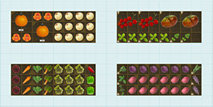How to grow Anise?
- Latin Family: Apiaceae
- Latin Genus: Pimpinella
- Ease of Growing: Moderate
- Growing Type: Annual
Seeds are often used in applesauce, breads, soups, and teas for a licorice-like flavor. Leaves can be used in salads. Does best in cool weather. Each plant produces between 1 and 2 Tbs of seeds (which are actually fruits).
Medicinal: Hot tea helps break up bronchial mucous. It is also a digestive aid for relief of flatulence and cramping.
Anise History
Native to the Eastern Mediterranean.
Soil Preference
- PH (min/max): 6.0 - 7.3
- PH Ideal (min/max): 6.5 - 7.0
Anise prefers a light, sandy soil that drains well.
How to care for Anise?
Anise is a fairly trouble free plant and doesn't need much care. You will want to be sure to keep flowering plants well watered.
Water
Keep soil evenly moist (but not soggy) while germinating, watering once a day if necessary. Continue to keep the soil moist throughout the plant's life, especially during flowering and seed production - this is the most crucial time for the plant.
Fertilizer
Anise has moderate nutrient requirements.
Seeds
Seed Viability: 2 - 3 years
Germination Percentage: 70.0
Anise is very easy to save seed from. The flowers are self-fertile and produce seed easily. As the seed ripens, put them in a paper bag to dry.
Light
Sun: min. 6 hours daily
Plant Anise in full sun.
Conditions:Cool, Warm
Season:Long Season
Storage
After drying the seeds, store them in an airtight container in a dark, cool, dry place.
Storage Req: Cool, Dry
Storage Temp: 60-70°F
Storage Length: 180-360 days
Problems
Anise Types
- Anise
Seeds are often used in applesauce, breads, soups, and teas for their licorice-like flavor. Leaves can be used in salads. Does best in cool weather. Each plant produces between 1 and 2 Tbs of seeds (which are actually fruits).
Medicinal: Hot tea helps break up bronchial mucous.
Carminative: a digestive aid for relief of gas and cramping.
Pests
- Aphids
- Crickets and Grasshoppers
- Caterpillars
Diseases
- Alternaria Blight
